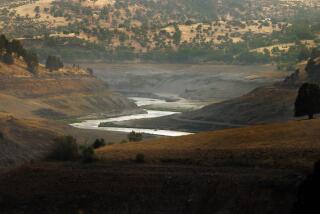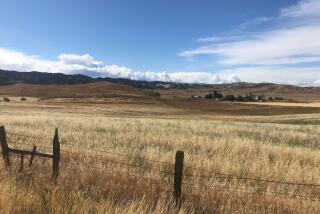
- Share via
- The federal government and California water agencies are planning a nearly $1-billion reservoir expansion.
- Raising the dam at San Luis Reservoir will increase its water-storing capacity for agencies that supply parts of the Bay Area and the San Joaquin Valley.
The Biden administration and eight California water agencies have reached an agreement to share in the costs of raising a dam to expand San Luis Reservoir, a nearly $1-billion project intended to increase the state’s water-storage capacity and benefit a group of urban communities and agricultural areas.
The plan to raise B.F. Sisk Dam and enlarge the reservoir near Los Banos will enable it to hold more water during wet years, boosting the reserves of water suppliers in parts of the Bay Area and the San Joaquin Valley.
“It’s going to add to resilience,” said Cannon Michael, board chair of the San Luis and Delta-Mendota Water Authority. “The ability to capture more water in the years it is available, particularly given California’s dynamic hydrology, is a critical component of a more secure future.”
New research shows global warming has become the dominant driver of worsening drought in the western United States.
Michael and other water managers who negotiated the agreement attended an event with federal officials in Washington as the U.S. Bureau of Reclamation announced the deal on Wednesday. California Gov. Gavin Newsom and Sen. Alex Padilla joined them, along with other state leaders.
Michael said expanding the reservoir, which still requires additional efforts to secure funding, will be a significant step in preparing the state for the effects of climate change, including shrinking snowpack and flashier bursts of storm runoff. At the same time, he said, it will be vital for California to ensure protection of fish species in the Sacramento-San Joaquin River Delta, where water is pumped to fill San Luis and other reservoirs.
“We are facing real shifts in climate that are showing us that we’ve got to learn how to adapt,” Michael said. “If and when there is excess water available, we want to be able to store it and hold on to it, and use it wisely.”
The dam is now undergoing a retrofit that will raise its crest by 10 feet and fortify the dam for earthquake safety. The Bureau of Reclamation and local agencies have agreed in principle to raise the dam an additional 10 feet to expand the reservoir’s storage capacity, making it a total of 20 feet taller than its original height.

San Luis Reservoir, which ranks among California’s largest reservoirs, is slated to gain an additional 130,000 acre-feet of storage space — equivalent to the annual water use of roughly 400,000 typical homes.
According to the federal government, that additional space will increase supplies for about 2 million people, more than 1 million acres of farmland, and wetlands in the Central Valley that provide critical habitat for birds and other wildlife.
The federal government has so far contributed $95 million toward the construction.
Local California agencies that have agreed to help fund the project include urban suppliers such as the Santa Clara Valley Water District, or Valley Water, which serves San Jose and other Silicon Valley cities; San Benito County Water District; and the city of Tracy. Also participating are agricultural water suppliers such as Westlands Water District, Del Puerto Water District and Pacheco Water District.
San Luis Reservoir is part of California’s two main water-delivery systems — the State Water Project and the federally managed Central Valley Project — and its more than 2 million acre-feet of storage space is divided between the two systems, providing an important reserve of supplies south of the Delta.
The dam, which is 382 feet tall and more than 3 miles long, was built between 1963 and 1967. It is owned by the federal government and operated by the state’s Department of Water Resources.
The Bureau of Reclamation said its endorsement of the project last year was the first approval of a major water storage project in California since 2011.
Managers of local water agencies said the project also represents the first major effort to expand the Central Valley Project’s storage capacity since the construction of New Melones Dam in the 1970s.

Karl Stock, the Bureau of Reclamation’s regional director, said adding more storage capacity in the reservoir is a “crucial part of our strategy for enhancing water reliability” in the state.
Based on the current plan and cost estimates, Westlands Water District would contribute approximately $88 million, and in exchange would be entitled to a portion of the extra storage space in the reservoir — about 11,000 acre-feet, which would be available when the reservoir fills in a wet year, said Allison Febbo, the district’s general manager.
“We believe storage is very important,” Febbo said.
The reservoir expansion will support supplies for the district’s farms in Fresno and Kings counties — which produce almonds, pistachios, tomatoes and other crops — and will also help local efforts to recharge groundwater, Febbo said.
In addition, plans for the project demonstrate how different agencies working together can make needed investments in upgrading the state’s aging water systems, Febbo said, a crucial step toward “showing that we are going to be improving and maintaining our infrastructure for Californians.”
The Newsom administration is projecting that California’s State Water Project could lose up to 23% of its water delivering capacity within 20 years.
The raising of the dam is expected to take years to complete.
The project isn’t “across the finish line” because funding still needs to be secured, Michael said. But he said the completion of negotiations among the agencies puts the effort on track to move ahead.
In addition to raising the dam, a substantial portion of the project’s cost is expected to come from moving and redesigning a mile-long section of State Route 152, which runs close to the reservoir’s high-water shoreline.
Michael and others say they are optimistic that if all goes as planned, the work of expanding the reservoir could be completed in less than 10 years.









